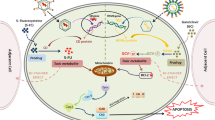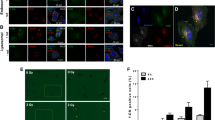Abstract
In the present study, we compared the therapeutic effect of tumor-selective retroviral replicating vectors (RRV) expressing the yeast cytosine deaminase (CD) delivered by convection-enhanced delivery (CED) or simple injection, followed by systemic administration of the pro-drug, 5-fluorocytosine (5-FC). Treatment with RRV-CD and systemic 5-FC significantly increased survival in rodent U87MG glioma model in comparison with controls (P<0.01). Interestingly, CED of RRV-CD followed by 5-FC further enhanced survival in this animal model in comparison with intra-tumoral injection of RRV-CD, followed by systemic 5-FC (P<0.05). High expression levels of Ki-67 were found in untreated tumors compared with treated. Untreated tumors were also much larger than treated. CED resulted in excellent distribution of RRV while only partial distribution of RRV was obtained after injection. Furthermore, RRV-CD and CD were also found in tumors from treated rats at study end points. These results demonstrated that RRV vectors may efficiently transduce and stably propagate in malignant human glioma, thereby achieving a significant in situ amplification effect after initial administration. We conclude that delivery of RRV into the glioma by CED provides much wider vector distribution than simple injection, and this correlated with better therapeutic outcomes.
This is a preview of subscription content, access via your institution
Access options
Subscribe to this journal
Receive 12 print issues and online access
$259.00 per year
only $21.58 per issue
Buy this article
- Purchase on Springer Link
- Instant access to full article PDF
Prices may be subject to local taxes which are calculated during checkout





Similar content being viewed by others
References
Davis FG, Freels S, Grutsch J, Barlas S, Brem S . Survival rates in patients with primary malignant brain tumors stratified by patient age and tumor histological type: an analysis based on Surveillance, Epidemiology, and End Results (SEER) data, 1973-1991. J Neurosurg 1998; 88: 1–10.
DeAngelis LM . Brain tumors. N Engl J Med 2001; 344: 114–123.
Holland EC . Glioblastoma multiforme: the terminator. Proc Natl Acad Sci USA 2000; 97: 6242–6244.
Brandes AA, Fiorentino MV . The role of chemotherapy in recurrent malignant gliomas: an overview. Cancer Invest 1996; 14: 551–559.
Hau P, Fabel K, Baumgart U, Rummele P, Grauer O, Bock A et al. Pegylated liposomal doxorubicin-efficacy in patients with recurrent high-grade glioma. Cancer 2004; 100: 1199–1207.
Wang W, Tai CK, Kershaw AD, Solly SK, Klatzmann D, Kasahara N et al. Use of replication-competent retroviral vectors in an immunocompetent intracranial glioma model. Neurosurg Focus 2006; 20: E25.
Tai CK, Wang WJ, Chen TC, Kasahara N . Single-shot, multicycle suicide gene therapy by replication-competent retrovirus vectors achieves long-term survival benefit in experimental glioma. Mol Ther 2005; 12: 842–851.
Ostertag D, Amundson KK, Lopez Espinoza F, Martin B, Buckley T, Galvao da Silva AP et al. Brain tumor eradication and prolonged survival from intratumoral conversion of 5-fluorocytosine to 5-fluorouracil using a nonlytic retroviral replicating vector. Neuro Oncol 2012; 14: 145–159.
Sgorbissa A, Tomasella A, Potu H, Manini I, Brancolini C, Type I . IFNs signaling and apoptosis resistance in glioblastoma cells. Apoptosis 2011; 16: 1229–1244.
Amano S, Gu C, Koizumi S, Tokuyama T, Namba H . Tumoricidal bystander effect in the suicide gene therapy using mesenchymal stem cells does not injure normal brain tissues. Cancer letters 2011; 306: 99–105.
Huber MH, Shirinian M, Lippman SM, Dimery IW, Frankenthaler RA, Hong WK . Phase I/II study of cisplatin, 5-fluorouracil and alpha-interferon for recurrent carcinoma of the head and neck. Invest New Drugs 1994; 12: 223–229.
Lang FF, Bruner JM, Fuller GN, Aldape K, Prados MD, Chang S et al. Phase I trial of adenovirus-mediated p53 gene therapy for recurrent glioma: biological and clinical results. J Clin Oncol 2003; 21: 2508–2518.
Walther W, Stein U . Viral vectors for gene transfer: a review of their use in the treatment of human diseases. Drugs 2000; 60: 249–271.
Bobo RH, Laske DW, Akbasak A, Morrison PF, Dedrick RL, Oldfield EH . Convection-enhanced delivery of macromolecules in the brain. Proc Natl Acad Sci USA 1994; 91: 2076–2080.
Hadaczek P, Yamashita Y, Mirek H, Tamas L, Bohn MC, Noble C et al. The "perivascular pump" driven by arterial pulsation is a powerful mechanism for the distribution of therapeutic molecules within the brain. Mol Ther 2006; 14: 69–78.
Eberling JL, Jagust WJ, Christine CW, Starr P, Larson P, Bankiewicz KS et al. Results from a phase I safety trial of hAADC gene therapy for Parkinson disease. Neurology 2008; 70: 1980–1983.
Gill SS, Patel NK, Hotton GR, O'Sullivan K, McCarter R, Bunnage M et al. Direct brain infusion of glial cell line-derived neurotrophic factor in Parkinson disease. Nat Med 2003; 9: 589–595.
Kunwar S . Convection enhanced delivery of IL13-PE38QQR for treatment of recurrent malignant glioma: presentation of interim findings from ongoing phase 1 studies. Acta Neurochir Suppl 2003; 88: 105–111.
Mardor Y, Roth Y, Lidar Z, Jonas T, Pfeffer R, Maier SE et al. Monitoring response to convection-enhanced taxol delivery in brain tumor patients using diffusion-weighted magnetic resonance imaging. Cancer Res 2001; 61: 4971–4973.
Richardson RM, Larson PS, Bankiewicz KS . Gene and cell delivery to the degenerated striatum: status of preclinical efforts in primate models. Neurosurgery 2008; 63: 629–442.
Perez OD, Logg CR, Hiraoka K, Diago O, Burnett R, Inagaki A et al. Design and selection of toca 511 for clinical use: modified retroviral replicating vector with improved stability and gene expression. Mol Ther 2012; 20: 1689–1698.
Bankiewicz KS, Eberling JL, Kohutnicka M, Jagust W, Pivirotto P, Bringas J et al. Convection-enhanced delivery of AAV vector in parkinsonian monkeys; in vivo detection of gene expression and restoration of dopaminergic function using pro-drug approach. Exp Neurol 2000; 164: 2–14.
Saito R, Bringas JR, Panner A, Tamas M, Pieper RO, Berger MS et al. Convection-enhanced delivery of tumor necrosis factor-related apoptosis-inducing ligand with systemic administration of temozolomide prolongs survival in an intracranial glioblastoma xenograft model. Cancer Res 2004; 64: 6858–6862.
Saito R, Bringas JR, McKnight TR, Wendland MF, Mamot C, Drummond DC et al. Distribution of liposomes into brain and rat brain tumor models by convection-enhanced delivery monitored with magnetic resonance imaging. Cancer Res 2004; 64: 2572–2579.
Yin D, Forsayeth J, Bankiewicz KS . Optimized cannula design and placement for convection-enhanced delivery in rat striatum. J Neurosci Methods 2010; 187: 46–51.
Wigmore PM, Mustafa S, El-Beltagy M, Lyons L, Umka J, Bennett G . Effects of 5-FU. Adv Exp Med Biol 2010; 678: 157–164.
Menei P, Boisdron-Celle M, Croue A, Guy G, Benoit JP . Effect of stereotactic implantation of biodegradable 5-fluorouracil-loaded microspheres in healthy and C6 glioma-bearing rats. Neurosurgery 1996; 39: 117–123.
Fournier E, Passirani C, Montero-Menei C, Colin N, Breton P, Sagodira S et al. Therapeutic effectiveness of novel 5-fluorouracil-loaded poly(methylidene malonate 2.1.2)-based microspheres on F98 glioma-bearing rats. Cancer 2003; 97: 2822–2829.
Benoit JP, Faisant N, Venier-Julienne MC, Menei P . Development of microspheres for neurological disorders: from basics to clinical applications. J Control Release 2000; 65: 285–296.
Mittermeyer G, Christine CW, Rosenbluth KH, Baker SL, Starr P, Larson P et al. Long-term evaluation of a phase 1 study of AADC gene therapy for Parkinson’s Disease. Hum Gene Ther 2012; 23: 377–381.
Richardson RM, Kells AP, Martin AJ, Larson PS, Starr PA, Piferi PG et al. Novel platform for MRI-guided convection-enhanced delivery of therapeutics: preclinical validation in nonhuman primate brain. Stereotact Funct Neurosurg 2011; 89: 141–151.
Saito R, Krauze MT, Bringas JR, Noble C, McKnight TR, Jackson P et al. Gadolinium-loaded liposomes allow for real-time magnetic resonance imaging of convection-enhanced delivery in the primate brain. Exp Neurol 2005; 196: 381–389.
Krauze MT, McKnight TR, Yamashita Y, Bringas J, Noble CO, Saito R et al. Real-time visualization and characterization of liposomal delivery into the monkey brain by magnetic resonance imaging. Brain Res Brain Res Protoc 2005; 16: 20–26.
Fiandaca MS, Forsayeth JR, Dickinson PJ, Bankiewicz KS . Image-guided convection-enhanced delivery platform in the treatment of neurological diseases. Neurotherapeutics 2008; 5: 123–127.
Yin D, Valles FE, Fiandaca MS, Bringas J, Gimenez F, Berger MS et al. Optimal region of the putamen for image-guided convection-enhanced delivery of therapeutics in human and non-human primates. Neuroimage 2009; 187: 46–51.
Yin D, Richardson RM, Fiandaca MS, Bringas J, Forsayeth J, Berger MS et al. Cannula placement for effective convection-enhanced delivery in the non-human primate thalamus and brainstem: Implications for clinical delivery of therapeutics. J Neurosurg 2010; 113: 240–248.
Acknowledgements
This study was supported with funds from Tocagen, San Diego, CA, USA and by a translational NIH grant to NK (U01-NS059821).
Author information
Authors and Affiliations
Corresponding author
Ethics declarations
Competing interests
Harry Gruber, Carlos Ibanez, Joan Robbins and Douglas Jolly are employees of Tocagen, which funded this study. Noriyuki Kasahara is a consultant and co-founder of Tocagen and has received research support from the company.
Rights and permissions
About this article
Cite this article
Yin, D., Zhai, Y., Gruber, H. et al. Convection-enhanced delivery improves distribution and efficacy of tumor-selective retroviral replicating vectors in a rodent brain tumor model. Cancer Gene Ther 20, 336–341 (2013). https://doi.org/10.1038/cgt.2013.25
Received:
Accepted:
Published:
Issue Date:
DOI: https://doi.org/10.1038/cgt.2013.25
Keywords
This article is cited by
-
Recent trends in the development of hydrogel therapeutics for the treatment of central nervous system disorders
NPG Asia Materials (2022)
-
Optimizing oncolytic virotherapy in cancer treatment
Nature Reviews Drug Discovery (2019)
-
Folate receptor-targeted novel boron compound for boron neutron capture therapy on F98 glioma-bearing rats
Radiation and Environmental Biophysics (2019)
-
Rethinking cancer nanotheranostics
Nature Reviews Materials (2017)
-
Deimmunization for gene therapy: host matching of synthetic zinc finger constructs enables long-term mutant Huntingtin repression in mice
Molecular Neurodegeneration (2016)



